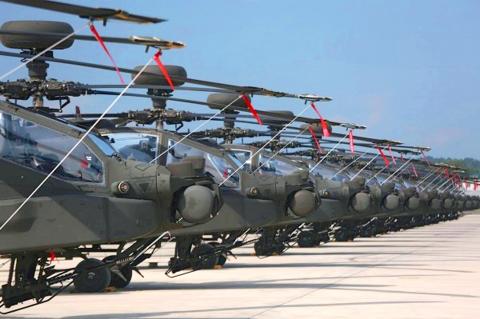The nation’s second squadron of Apache attack helicopters is likely to enter service later this year after the first squadron was commissioned last year by the Army Aviation and Special Forces Command, an army officer said yesterday.
After undergoing rigorous testing, the second Apache combat team is expected to be commissioned in the middle of this year, said the officer, who spoke on condition of anonymity.
The launch of the first squadron has shown that the Apache helicopters are combat-ready, while the formation of the additional squadron means it has full combat and defense capabilities, he said.

Photo: Courtesy of the Military News Agency
The command’s 601st Brigade has been training personnel and upgrading its equipment since 2013, the command said, adding that after more than two years of training, one of the two Apache squadrons was commissioned in June last year and has since then contributed greatly to improving the army’s combat capability.
Taiwan in 2008 ordered 30 Boeing AH-64E Apache helicopters from the US for about NT$59.3 billion (US$2.01 billion at the current exchange rate), including personnel training and logistics, and took delivery of the aircraft from November 2013 to October 2014.
One of the helicopters was destroyed in April 2014 after it crashed during a training flight in Taoyuan.
The AH-64E is also known as a “tankbuster.” It is equipped with powerful target acquisition radar that is capable of 360-degree operation for up to 8km, and can simultaneously track up to 128 targets and engage the 16 most dangerous, the command said, adding that it carries 16 Hellfire missiles and can deploy them in less than 30 seconds.
In related news, the army has decided to start phasing out its Bell UH-1H helicopters by the end of this year, even though there are not enough Sikorsky UH-60M Black Hawk helicopters to replace them, an anonymous defense official said yesterday.
Although the military originally intended to replace the army’s aging UH-1H fleet with the 60 UH-60Ms it bought from the US, half of the Black Hawks were later allotted to other aviation services, the official said.
President Tsai Ing-wen (蔡英文) and former president Ma Ying-jeou (馬英九) each ordered the reassignment of 15 aircraft to the Air Rescue Group and the National Airborne Service Corps respectively, leaving only 30 Black Hawks for the army, the official said.
While the army has held off retiring the UH-1Hs, their ready rate and maintenance costs are no longer acceptable, the official said.
The army believes that the government should buy another 32 UH-60M helicopters from the US, if budget allows, the official said.
Taiwan from 1970 to 1976 built 118 UH-1H helicopters under license, meaning that the last batch of airframes are 42 years old, the official said.
The army intends to donate some of the phased-out aircraft to technical training schools, they added.

LIMITS: While China increases military pressure on Taiwan and expands its use of cognitive warfare, it is unwilling to target tech supply chains, the report said US and Taiwan military officials have warned that the Chinese People’s Liberation Army (PLA) could implement a blockade within “a matter of hours” and need only “minimal conversion time” prior to an attack on Taiwan, a report released on Tuesday by the US Senate’s China Economic and Security Review Commission said. “While there is no indication that China is planning an imminent attack, the United States and its allies and partners can no longer assume that a Taiwan contingency is a distant possibility for which they would have ample time to prepare,” it said. The commission made the comments in its annual

DETERMINATION: Beijing’s actions toward Tokyo have drawn international attention, but would likely bolster regional coordination and defense networks, the report said Japanese Prime Minister Sanae Takaichi’s administration is likely to prioritize security reforms and deterrence in the face of recent “hybrid” threats from China, the National Security Bureau (NSB) said. The bureau made the assessment in a written report to the Legislative Yuan ahead of an oral report and questions-and-answers session at the legislature’s Foreign Affairs and National Defense Committee tomorrow. The key points of Japan’s security reforms would be to reinforce security cooperation with the US, including enhancing defense deployment in the first island chain, pushing forward the integrated command and operations of the Japan Self-Defense Forces and US Forces Japan, as

‘TROUBLEMAKER’: Most countries believe that it is China — rather than Taiwan — that is undermining regional peace and stability with its coercive tactics, the president said China should restrain itself and refrain from being a troublemaker that sabotages peace and stability in the Indo-Pacific region, President William Lai (賴清德) said yesterday. Lai made the remarks after China Coast Guard vessels sailed into disputed waters off the Senkaku Islands — known as the Diaoyutai Islands (釣魚台) in Taiwan — following a remark Japanese Prime Minister Sanae Takaichi made regarding Taiwan. Takaichi during a parliamentary session on Nov. 7 said that a “Taiwan contingency” involving a Chinese naval blockade could qualify as a “survival-threatening situation” for Japan, and trigger Tokyo’s deployment of its military for defense. Asked about the escalating tensions

The Ministry of Economic Affairs said it plans to revise the export control list for strategic high-tech products by adding 18 items under three categories — advanced 3D printing equipment, advanced semiconductor equipment and quantum computers — which would require local manufacturers to obtain licenses for their export. The ministry’s announcement yesterday came as the International Trade Administration issued a 60-day preview period for planned revisions to the Export Control List for Dual Use Items and Technology (軍商兩用貨品及技術出口管制清單) and the Common Military List (一般軍用貨品清單), which fall under regulations governing export destinations for strategic high-tech commodities and specific strategic high-tech commodities. The